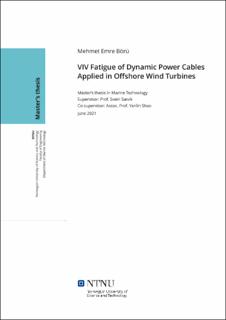| dc.description.abstract | In this work, the effect of vortex-induced vibrations (VIV) on the fatigue strength of subsea power cables were investigated by the implementation of a non-linear time domain analysis methodology. To have a better understanding of VIV, experiments and empirical models for VIV were explained. Besides, several examples for frequency and time domain VIV models were given. Furthermore, relevant standards for the fatigue design of subsea dynamic power cables were addressed.
A linear global finite element model of the power cable in SIMLA software to establish tension and curvature time histories and the local model of the cable cross-section in BFLEX software to obtain axial stress signals for various points in the cable were created. Case scenario was analysed by considering both the hogging and the sagging sections for 4 different conditions and 7 different loading cases for each conditions. First condition considers VIV and all environmental loads. Second exclude VIV but keeping other parameters the same. For the third condition, wave loads are not taken into account by a filtering process of tension and curvature time histories obtained by the global analysis. For the last condition, frictions between cable layers in the axial direction are deactivated in the local model.
Time series by global analyses are post-processed to be used in local analyses as input. Local analyses gave axial stress signals for the internal steel armor layer in three different points. Two of these points are selected to give the fatigue damage for maximum cross-flow and in-line responses. The other one is neutral for both in-line and cross-flow vibrations. In-plane and out-of-plane bending moments and the axial force for centre body of the cable cross-section which includes copper conductors were computed. By using these time series axial stresses in the centre body were calculated analytically for 3 different points based on the same concept applied for the steel armor layer. Having evaluated stress signals, Rainflow algorithm was used to separate them into stress ranges and corresponding cycles. Then, Miner's Sum was introduced to calculate accumulated fatigue damage for each location in each condition.
Analyses have shown that the internal steel armor is the governing layer for the fatigue life. Especially, the fatigue damage in the CF direction appeared to be the maximum due to large out-of-plane curvatures. The fatigue life is the lowest also in the CF direction for the centre body. However, fatigue lives for the centre body are much larger compared to ones for the internal steel armor. That is because external loads are taken by the internal armor layer.
In addition, environmental loads, especially wave loads, appeared to be an important aspect for the fatigue design of such structures, especially with respect to the increased drag forces. Thus, environmental conditions of the operational area should be taken into account during the design process.
Lastly, frictions between the contact surfaces take an important part of the fatigue damage. Special anti-corrosive actions might be taken to reduce the fatigue damage accumulation due to the friction. | |
